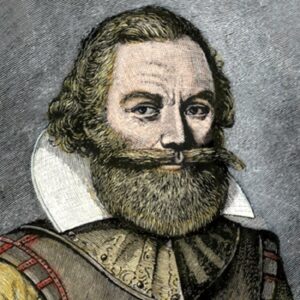John Smith was an English soldier and explorer who was instrumental in the founding of Jamestown, North America’s first permanent English settlement. He led a thorough survey of the territories surrounding Virginia and documented the Chesapeake Bay area and New England while in North America, becoming the first English explorer to do so. He was an accomplished mapmaker, and his abilities considerably aided the English in their exploration of new places for colonization in the New World. He grew up in an agricultural household and had a strong desire to travel and explore. His father died when he was 16, and he left home at the age of 16 to pursue his dreams. He went to France and fought alongside the French army in the war for Dutch freedom from King Phillip II of Spain. He went to Hungary to battle the Turks after returning to England and studying riding. He returned to England after being captured by the enemy, receiving ill treatment, and eventually escaping his tormentors. His adventures fueled his desire for adventure even more, and he became associated with the Virginia Company, which sponsored a North American expedition. In 1607, the English arrived in Jamestown, and Smith was instrumental in establishing the land as an English colony.
Childhood and Adolescence
John Smith was either born in 1579 or 1580. He was baptized on January 6, 1580, at Willoughby near Alford, Lincolnshire, according to records.
From 1592 until 1595, he attended King Edward VI Grammar School in Louth. He was apprenticed to a wealthy businessman when he was a teenager.
John’s father died when he was 16 years old. He left home, a natural explorer, to pursue his riches.
A Later Years
He fought for Dutch freedom from Spanish King Phillip II as a volunteer in Henry IV of France’s army. By 1599, he had returned to England.
He returned home and spent two years researching ancient military classics as well as receiving horsemanship training. In 1601, he traveled to Hungary in search of more adventure, joining the Austrian army battling the Ottoman Empire. He was a valiant fighter who rose through the ranks to captain.
In 1602 he was kidnapped by the enemy and carried to Turkey, where he was forced to work as a slave. When his master treated him badly, he revolted and killed him, then made his way to Russia. In 1604 or 1605, he eventually returned to England.
King James issued a charter to the Virginia Company of London, which sought to colonize the eastern coast of North America. In 1606 John Smith became associated with it and was assigned to the crew that would embark on this arduous journey.
The Discovery, the Susan Constant, and the Godspeed, three tiny ships carrying roughly a hundred colonists led by Christopher Newport, set off in December 1606. In April 1607, the colonists arrived at the Chesapeake Bay and began the process of establishing Jamestown.
The colonists first battled to stay alive. Many died of diseases and infections in the first few days after arriving. They were also faced with a food deficit. Smith, who was bold and inventive, proved to be extremely effective in obtaining food for his men from the indigenous.
He was taken in December 1607 by troops sent by Chief Powhatan, the Chesapeake region’s supreme commander. Initially, he was scheduled to be slain, but the chief intervened at the last minute to save his life.
By September 1608, Smith had been elected president of the colony’s council. More immigrants had come by this time, and it was getting increasingly difficult to feed everyone.
As a result, John Smith enacted stringent laws requiring the colonists to labor in order to earn food, or they would starve.
He pushed his people to farm and required them to work long and arduous hours. Initially, he maintained friendly connections with the Indians, but later on, he began exploiting the natives to gather food for his own men.
His harsh treatment of his own men, as well as his deteriorating ties with the natives, won him a number of foes. He was seriously hurt in a mystery gunpowder explosion one night, which could have been a botched assassination attempt by his foes.
In 1609, he departed for England and never returned to North America. In his senior years, he wrote novels about his adventures as an explorer.
‘True Relation of Virginia’ (1608), ‘Map of Virginia’ (1612), ‘The Generall Historie of Virginia, New England, and the Summer Isles’ (1624), and ‘True Travels’ are some of his most notable literary works (1630).
His Major Projects
John Smith is well remembered for his involvement in establishing Jamestown, the first permanent English settlement in North America, in North America.
He overcame many obstacles in his efforts to establish the territory as an English colony, but he did not give up. Despite all of the obstacles he faced, including threats to his life, he persisted in defending the English-claimed property.
Personal History and Legacy
John Smith was never married and never had children.
At the age of 51, he died on June 21, 1631. In 1633, he was buried in Holborn Viaduct’s Saint Sepulchre-without-Newgate Church.
He was recognized on two of the three stamps issued in 1907 to commemorate the founding of the Jamestown settlement during the Jamestown Exposition in Norfolk, Virginia.
Estimated Net worth
John Smith is one of the wealthiest TV actors and one of the most well-known. John Smith’s net worth is estimated to be $1.5 million, according to Wikipedia, Forbes, and Business Insider.


